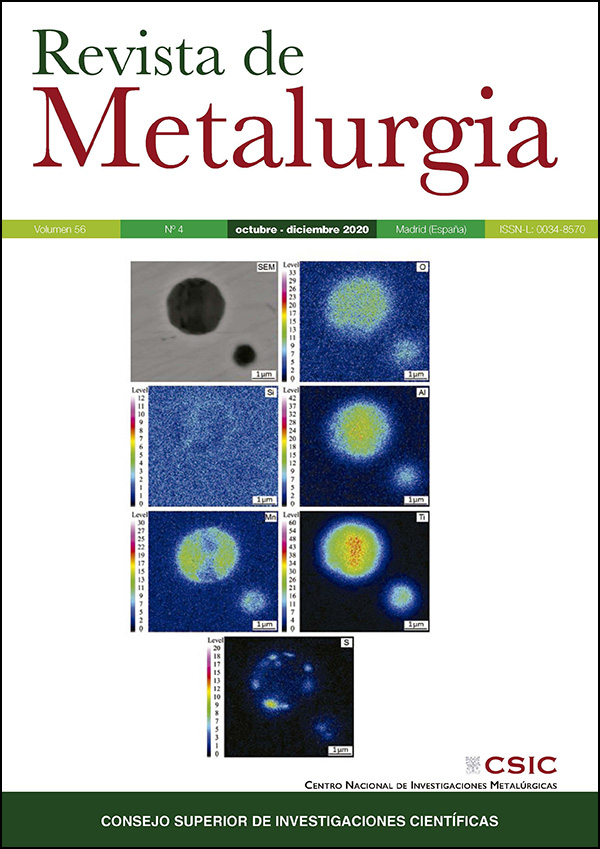The removal of toxic metals from liquid effluents by ion exchange resins. Part XIV: Indium(III)/H+/Dowex-400
DOI:
https://doi.org/10.3989/revmetalm.184Keywords:
Dowex-400, Indium(III), Liquid effluents, RemovalAbstract
The removal of indium(III) from aqueous solutions by the cationic exchanger Dowex-400 has been investigated measuring the percentage of metal removal from the solution as a function of different resin dosages and pH values of the aqueous phase. The variation of the stirring speed (300–1000 min−1) applied to the system has a negligible effect on the removal of indium(III) from the solution; being the rate law associated to the ion exchange process best fitted to a film-diffusion controlled model. The exchange reaction is exothermic (ΔH°= -90 kJ·mol−1), and the kinetics models of the exchange process are temperature dependent: pseudo-first order at 20 °C, second order at 30 °C and pseudo-second order at 40 °C. The decrease of the aqueous pH value (from 1 to 0) decreases the percentage of metal removal from the solution. The metal uptake onto the resin is best represented by the Langmuir type-2 adsorption model. Indium(III) loaded onto the resin can be eluted by the use of acidic solutions, regenerating the resin at the same time.
Downloads
References
Alguacil, F.J., Coedo, A.G., Dorado, T., Padilla, I. (2002). The removal of toxic metals from liquid effluents by ion exchange resins. Part I: chromium(VI)/sulphate/Dowex 1x8. Rev. Metal. 38, 306-311. https://doi.org/10.3989/revmetalm.2002.v38.i4.412
Alguacil, F.J. (2002). The removal of toxic metals from liquid effluents by ion exchange resins. Part II: cadmium(II)/sulphate/Lewatit TP260. Rev. Metal. 38, 348-352. https://doi.org/10.3989/revmetalm.2002.v38.i5.418
Alguacil, F.J. (2003). The removal of toxic metals from liquid effluents by ion exchange resins. Part III: copper(II)/sulphate/Amberlite 200. Rev. Metal. 39, 205-209. https://doi.org/10.3989/revmetalm.2003.v39.i3.330
Alguacil, F.J. (2017a). The removal of toxic metals from liquid effluents by ion exchange resins. Part IV: chromium(III)/H+/Lewatit SP112. Rev. Metal. 53 (2), e093.
Alguacil, F.J. (2017b). The removal of toxic metals from liquid effluents by ion exchange resins. Part V: nickel(II)/H+/Dowex C400. Rev. Metal. 53 (4), e105.
Alguacil, F.J. (2018a). The removal of toxic metals from liquid effluents by ion exchange resins. Part VI: manganese(II)/H+/Lewatit K2621. Rev. Metal. 54 (2), e116.
Alguacil, F.J. (2018b). The removal of toxic metals from liquid effluents by ion exchange resins. Part VII: manganese(VII)/H+/Amberlite 958. Rev. Metal. 54 (3), e125.
Alguacil, F.J., Escudero, E. (2018). The removal of toxic metals from liquid effluents by ion exchange resins. Part VIII: Arsenic(III)/OH−/Dowex 1x8. Rev. Metal. 54 (4), e132.
Alguacil, F.J. (2019a). The removal of toxic metals from liquid effluents by ion exchange resins. Part IX: lead(II)/H+/Amberlite IR120. Rev. Metal. 55 (1), e138.
Alguacil, F.J. (2019b). The removal of toxic metals from liquid effluents by ion exchange resins. Part X: antimony(III)/H+/Ionac SR7. Rev. Metal. 55 (3), e152.
Alguacil, F.J. (2019c). The removal of toxic metals from liquid effluents by ion exchange resins. Part XI: cobalt(II)/H+/Lewatit TP260. Rev. Metal. 55 (4), e154.
Alguacil, F.J., Escudero, E. (2019). Solvent extraction of indium(III) from HCl solutions by the ionic liquid (A324H+)(Cl−) dissolved in Solvesso 100. Hydrometallurgy 189, 105104. https://doi.org/10.1016/j.hydromet.2019.105104
Alguacil, F.J., Escudero, E. (2020). The removal of toxic metals from liquid effluents by ion exchange resins. Part XII: mercury(II)/H+/Lewatit SP112. Rev. Metal. 56 (1), e160.
Alguacil, F.J. (2020). The removal of toxic metals from liquid effluents by ion exchange resins. Part XIII: zinc(II)/H+/ Lewatit OC-1026. Rev. Metal 56 (3), e172.
Araucz, K., Aurich, A., Kotodynska, D. (2020). Novel multiofunctional ion exchangers fro metal ions removal in the presence of citric acid. Chemosphere 251, 126332. https://doi.org/10.1016/j.chemosphere.2020.126331 PMid:32145572
Bayazit, G., Tastan, B,E, Gül, U.D. (2020). Biosorption, isotherm and kinetic properties of common textile dye by Phormidium animale. Global NEST J. 22 (1), 1-7.
Bezzina, J.P., Robshaw, T., Dawson, R., Ogden, M.D. (2020). Single metal isotherm study of the ion exchange removal of Cu(II), Fe(II), Pb(II) and Zn(II) from synthetic acetic acid leachate. Chem. Eng. J. 394, 124862. https://doi.org/10.1016/j.cej.2020.124862
Hubbe, M.A., Azizian, S., Douven, S. (2019). Implications of apparent pseudo-second-order adsorption kinetics onto cellulosic materials: a review. BioResources 14 (3), 7582-7626. https://doi.org/10.15376/biores.14.3.7582-7626
Jacukowicz-Sobala, J., Ocinski, D., Mazur, P., Stanislawska, E., Kociolak-Balawejder, E. (2020). Cu(II)-Fe(III) oxide doped anion exchangers-Multifunctional composites for arsenite removal from water as As(III) adsorption ands oxidation. J. Hazard. Mater. 394, 122527. https://doi.org/10.1016/j.jhazmat.2020.122527 PMid:32199203
Lee, J.-C., Kurniawan, Hong, H.-J. Chuong, K.W., Kim, S. (2020). Separation of platinum, palladium and rhodium from aqueous solutions using ion exchange resins: A review. Sep. Purif. Technol. 246, 116896. https://doi.org/10.1016/j.seppur.2020.116896
Lopez Diaz-Pavon, A., Cerpa, A., Alguacil, F.J. (2014). Processing of indium(III) solutions via ion exchange with Lewatit K-2621 resin. Rev. Metal. 50 (2), e010. https://doi.org/10.3989/revmetalm.010
Luz, A.L., Wu, X., Tokar, E.J. (2018). Toxicology of Inorganic Carcinogens (Chapter One). Adv. Molec. Toxicol. 12, 1-46. https://doi.org/10.1016/B978-0-444-64199-1.00002-6
Simonescu, C.M., Lavric, V., Musina, A., Antonescu, O.M., Culita, D.C., Marinescu, V., Tardei, C., Oprea, O., Oandele, A.M. (2020). Experimenatl and modeling of cadmium ions by chelating resins. J. Mol. Liq. 307, 112973. https://doi.org/10.1016/j.molliq.2020.112973
Schuyler Anderson, C. (2020). US Geological Survey, Accessed May 2020. https://pubs.usgs.gov.
Published
How to Cite
Issue
Section
License
Copyright (c) 2020 Consejo Superior de Investigaciones Científicas (CSIC)

This work is licensed under a Creative Commons Attribution 4.0 International License.
© CSIC. Manuscripts published in both the printed and online versions of this Journal are the property of Consejo Superior de Investigaciones Científicas, and quoting this source is a requirement for any partial or full reproduction.
All contents of this electronic edition, except where otherwise noted, are distributed under a “Creative Commons Attribution 4.0 International” (CC BY 4.0) License. You may read the basic information and the legal text of the license. The indication of the CC BY 4.0 License must be expressly stated in this way when necessary.
Self-archiving in repositories, personal webpages or similar, of any version other than the published by the Editor, is not allowed.
















